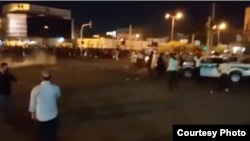Water shortage protests in drought-plagued southwestern Iran appear to have spread to more cities and taken on a sharper anti-government tone as the unrest extended into a sixth night.
Videos shared with VOA Persian and posted to social media showed what appeared to be protesters chanting “Death to Khamenei” and “Reza Shah, bless your soul” in the city of Izeh in Iran’s Khuzestan province on Tuesday night local time. Gunshots also were heard in some of those videos.
VOA could not independently verify the videos. Iran has barred VOA from reporting inside the country.
“Death to Khamenei” has been a common refrain of Iranian anti-government protesters angered by the authoritarian rule of Supreme Leader Ayatollah Ali Khamenei in recent years. “Reza Shah, bless your soul” also has been uttered in previous waves of Iranian street protests as a sign of affection toward the founder of the nation’s former monarchy Reza Shah. Khamenei’s predecessor, Ayatollah Ruhollah Khomeini, ousted Reza Shah’s son from power in Iran’s 1979 Islamic Revolution.
An earlier series of videos that were sent to VOA Persian and posted on social media appeared to show Monday night protests in several other parts of Khuzestan, including the provincial capital, Ahvaz, and the cities of Andimeshk, Hamidiyeh, Ramhormoz, Shooshtar and Susangerd. Those clips showed protesters chanting slogans denouncing the lack of drinking and agricultural water in the province, with gunfire audible in some places. The images also could not be independently verified by VOA.
The protests initially erupted in Khuzestan late Thursday and turned deadly the next evening, when Iranian state media reported the killings of two men by gunfire during the demonstrations. Since then, videos have appeared to show the protests continuing on a nightly basis, marking what would be the widest and most sustained disturbances Iran has seen in months.
Iranian state media published what they called interviews with relatives of the two slain men describing their loved ones as being allied with Iran’s pro-government Basij militia. But Iranian social media users said they believed the relatives were coerced into absolving security forces of responsibility for the killings.
Many of the protesters seen in videos from the first two nights of the protests were chanting slogans in Arabic. Khuzestan is home to a significant ethnic Arab minority that long has complained of discrimination and neglect by the Islamist rulers of Persian-majority Iran.
But Tuesday’s apparent protest in Izeh, a city that is not predominantly Arab, indicated that the antigovernment protests sweeping Khuzestan are not driven only by ethnic minority grievances.
A group of prominent Iranian rights activists, including Narges Mohammadi, held a rally in front of Iran’s Interior Ministry in Tehran on Tuesday to express solidarity with the Khuzestan protesters.
A video shared on social media showed former political prisoners Mohammadi, Arash Sadeghi, Jafar Azimzadeh and several other activists gathered outside the ministry as Mohammadi spoke in defense of what she called the innocent people of Khuzestan.
Mohammadi’s husband, Taghi Rahmani, who lives in exile in France, tweeted Tuesday that his wife and some of the other activists at the rally were beaten and arrested by security forces. In a second tweet five hours later, Rahmani said they had all been released. There was no mention of the incident in Iranian state media.
Iran’s water shortages partly are the result of weather-related factors including a sharp drop in rainfall, which has been more than 40% below last year’s levels in recent months, combined with high summer temperatures.
Experts say decades of Iranian government mismanagement also have fueled the drought. They blame authorities’ poorly considered placement and construction of hydroelectric dams and the diversion of water from Khuzestan’s rivers and wetlands to industrial sites in neighboring regions, practices that have dried up sources of drinking and agricultural water for Khuzestan residents.
Iranian leaders were quoted in state media as saying they had sent delegations to Khuzestan in recent days to examine the water shortages and reports of fatal shootings of protesters.
The head of New York’s Center for Human Rights in Iran, Hadi Ghaemi appealed to the United Nations in a statement Monday to “forcefully call upon Iranian authorities to allow people to air their grievances without threats of violence or imprisonment.”
Responding to a VOA Persian question about the Khuzestan protests last Friday, U.S. State Department spokesperson Jalina Porter told a press briefing that Washington will “continue to urge the Iranian government to support the Iranian people as they exercise their universal rights to freedom of expression as well as freedom of peaceful assembly.” The Biden administration has not made any additional comments about the protests as they appeared to expand in the following days.
In a Monday interview with VOA Persian, France-based Iranian sociologist Jalal Idjadi said the water shortages have exacerbated the coronavirus pandemic in Khuzestan. He said provincial news reports suggest the percentage of the population that has received coronavirus vaccines is in the low single digits.
“The water shortage has impacted people’s health and spread of the coronavirus,” Idjadi said.
This article originated in VOA’s Persian Service. Click here to read the original Persian version of the story.








